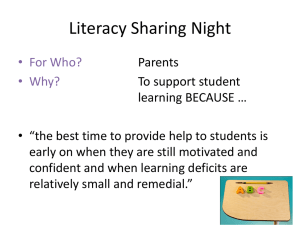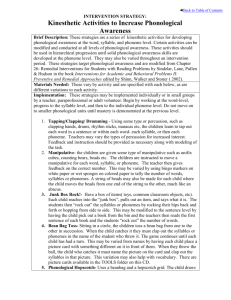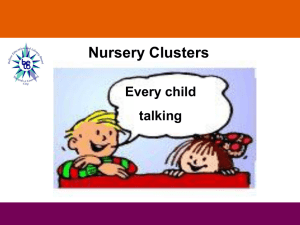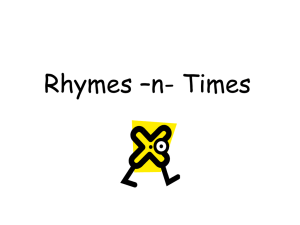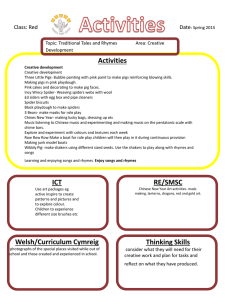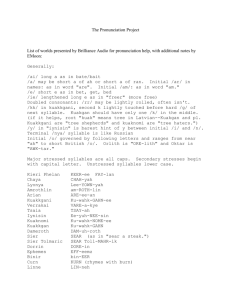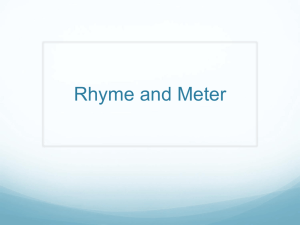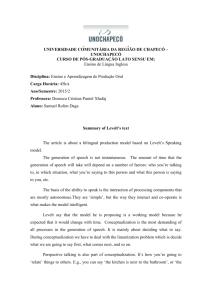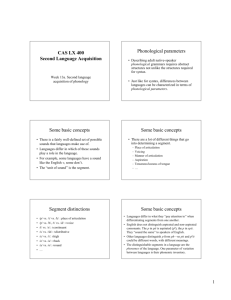Early Literacy Parent Workshop - Beaver Bank Kinsac Elementary
advertisement
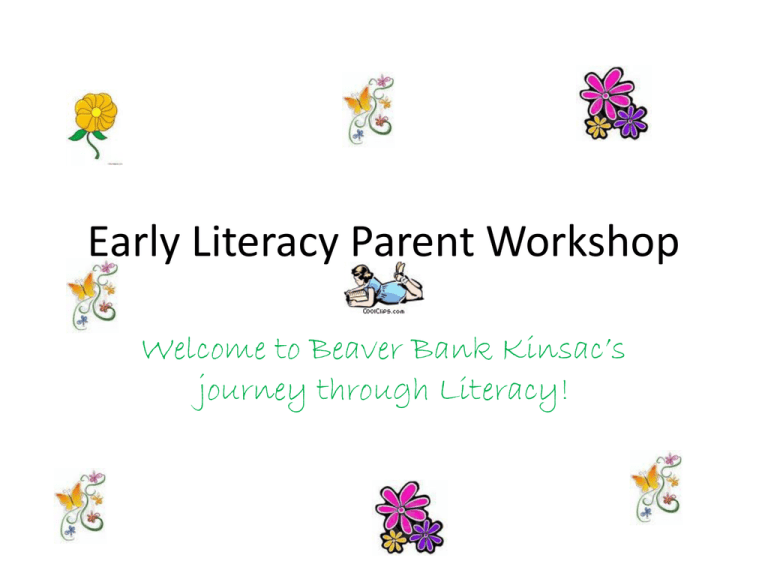
Early Literacy Parent Workshop Welcome to Beaver Bank Kinsac’s journey through Literacy! Parent –Teacher Links • “Parents belong at the center of a young child’s education. The single best way to improve elementary education is to strengthen the parents’ role in it, both by reinforcing their relationship with the school and by helping and encouraging them in their own critical job of teaching the young. Not all teachers are parents, but all parents are teachers.” -Bennett , W.J First Lessons: A Report on Elementary Education. Literacy Skills of Developing Readers Phonological Awareness • The umbrella term referring to the ability to attend to the sound structure of the language, not just the meaning. It includes awareness of words, syllables, rhymes, and sounds. • It is the ability to listen inside a word and play with the sounds. • More than twenty percent of students struggle with some aspects of phonological awareness. • Occurs initially in oral language, aware that words are separate entities, words can be broken into rhythmic parts(syllables) , that there is a special relationship between words that rhyme, and of individual sounds and can attend to them and manipulate them in a word, i.e. Gregory and green start the same. Supporting Phonological Awareness in the Classroom • Teacher Read-Alouds can call attention to word play and provides a meaningful and fun language experience. Teachers can have students listen for particular features of language helping students focus on the ‘sound of language’. It also provides them with practice in listening for purpose. (Could focus on rhythm or rhyme, syllable awareness, alliteration) • Shared Reading using Big Books, charts, overheads, with poems and songs to provide opportunities to focus on various features of print or phonological awareness. Teacher introduces story, poem or song and asks students to listen for the rhymes or listen for a particular sound. Once students are familiar with the text, they can clap syllables, use instruments to keep a beat, or be asked to supply left out word. Supporting Phonological Awareness in the Classroom • Shared Writing-Teacher and students work together to write a message or story. The teacher, who does the writing, demonstrates how writing works. The teacher may model rhyme analogy to spell a word(e.g. “I know how to spell ‘cat’, so how would I spell ‘hat’? The teacher may ‘share the pen’ when composing a story-Interactive Writing. • Morning Message activities. • Sentence Building-cut up stories. • Games-Word and sound detectives/hunting. • Singing –Adapt familiar songs, e.g. ‘A hunting we will go. A hunting we will go. We’ll find an /s/ and add an /un/ and now we have a ‘sun’. • Ball toss-rhyming activity Supporting Phonological Awareness at Home • Playing with Rhyme • - Share nursery rhymes, sing songs, or read books that have rhyming words. • Name things you see when your driving or shopping, and think of words that rhyme. • Play ‘Can you read my mind?’ Riddles. ‘I’m thinking of a word that rhymes with…’ Supporting Phonological Awareness at Home • Playing with Syllables • -Play a guessing game with syllables. Say a word by syllables and have your child guess what the word is. Ex: oc-to-pus • Take the syllable away-Say a word of 3 or 4 syllables and leave out the first syllable. • Playing with Sounds • Say a word and ask your child to tell you the sound(not the letter) that it starts with. • Ask your child to tell you the sound at the end of the word. • Talk about things around the house or in a book that start and end with the same sound. • Play ‘I Spy’ but give your clue using the sound at the beginning of the word, rather than the letter. Oral Language • Another predictor of Literacy success. • Students learn more about language by using it. • School places new demands on students’ communication skills. • Adjustments are made between informal communication at home and a more formal one used at school-need to develop flexible language systems, encompassing speaking, listening, and thinking-as well as language use in print. Oral Language in the Classroom • The rules for ‘talking in school’ have changed. We want children to be able to use their language skills to do more than just answer questions or repeat information. They need to be able to use language to describe, explain, retell, predict, problem-solve, interpret and plan. • The development of social language is important for success and students learn how to communicate effectively in a variety of situations for many purposes: -with a peer to solve a problem or for conversation about learning; -with a teacher in his or her varied roles; -in a small group for play or for completing a centre activity; -in the large- group setting for following directions, listening to a story, or sharing information. Supporting Oral Language in the Classroom • Children ‘learn to talk’ before entering school, and in school develop skills in ‘talking to learn’. They need to develop language that will enable them to: -develop hypotheses and test them out; -reflect on what they’ve observed; -make connections between what they know and new information; -problem-solve. • Because classrooms use interaction and conversation as the medium for learning, students need to develop social language skills that enable them to work successfully, whether independently, with a partner, in a small group , and in a whole class setting. • Time is spent with students defining rules and expectations and establishing routines for working and learning in the classroom. • Time is spent developing effective listening skills, learning to work effectively as partners. Supporting Oral Language at Home • Talk, talk and more talk Talk to your child about the events of the day. Teach and encourage new words…go beyond happy and sad, big or little. Try words like excited, frustrated, gigantic, and miniscule. Ask your child to get you the spatula out of the utensil drawer. Cooking and baking together is a great way to learn names for ingredients as well as action words such as blend, stir, and mix. Play ‘I Spy’ to learn describing words. Ask your child to find something that flies or crawls, something that has four legs but cannot walk or something that you can hear. During car rides have your child locate or make a list of different noises, moving things or rectangular things seen along the way. Give each child a different job. Supporting Oral Language at Home • Play with language. Riddles, jokes, and rhymes are fun! ‘Why did the gingerbread man go to the doctor?’ • Sing songs, rhymes. Play ‘Sing It’ or ‘Guitar Hero’. • Ask questions such as: ‘What did you read today? Tell me about it.’ ‘What did you learn today that you could teach me?’ ‘What did your teacher read to you today?’ ‘What did you do first? next? later? ‘What did you learn about yourself as a reader or writer?’ Supporting Reading Development in the Classroom Teacher’s role • Your child’s teacher creates a learning environment that is sensitive and responsive to your child’s individual needs. • She uses a variety of organizational approaches, including whole-class and small- group instruction, and independent learning. • She provides a balanced approach to reading instruction, meaning the children are exposed to 4 different kinds of reading experiences every day: Read-Aloud, Shared Reading, Guided Reading, and Independent Reading. Read-Aloud Teachers read aloud to the whole class so that children can: • • • • • • • • • Learn what good reading sounds like; Experience different types of texts(genres), different types of literature and author writing styles; Enjoy books they cannot read alone; Develop questioning and critical listening skills; Increase vocabulary; Expand linguistic repertoire; Develop a sense of story; Develop knowledge of written language syntax; Develop knowledge of text structure; Other purposes for Read-Alouds: • Demonstrates reading for a purpose; • Promote oral language development; • Establish known texts to use as a basis for writing and other reading activities. Shared Reading • Shared Reading is a collaborative language activity, where groups of students and the teacher or the whole class and the teacher read and reread stories, poems, songs, classmade chart stories, usually in enlarged print. Guided Reading In guided reading, teachers • Match instruction and reading materials to your child’s learning needs; • Work with a small number of children; • Build on your child’s strengths and skills to teach new reading strategies. Independent Reading In independent reading, your child is encouraged to read on his or her own in order to Practice reading and the strategies taught during mini-lessons; Respond to reading critically and thoughtfully; Read a variety of ‘Just Right’ Texts; Develop his or her interests as a reader. • • • • • ‘Just Right’ books are not so challenging that students are solely occupied with figuring out how to decode the words and not so easy that readers are unlikely to learn something new. Supporting Reading Development at Home • • • • • • • • • Read, Read and re-read Read to and with your child every day : Encourage your child to join in when reading familiar stories or favorite lines. Reread favorite stories. Listen as your child reads to you. Set aside the same time to read every day to establish a routine. Set an example. Children need to see you reading, too. Provide positive role models. Encourage your child’s attempts at reading. Be generous with your praise and support. When you show confidence, your child will feel it. Surround your child with reading materials. Provide a variety of texts to read: fiction and non-fiction, poems, comics, magazines, newspapers. Read for enjoyment and information. Talk about stories. To develop comprehension, talk about the stories you read together. Occasionally pause and ask your child to make predictions-‘What do you think might happen next?’ Ask if they liked or didn’t like the story and why. Ask if they were wondering about anything in the story or if they had any questions and why. Be an example of fluent reading. Change your voice for different characters and sometimes exaggerate exclamation and question marks. At Home Reading (Books from school) • The teacher sends home books your child has already explored in the classroom. They should be familiar books. It is important that we use familiar books that are easy to improve their fluency. • • FLUENCYReading fluently means reading without noticeable cognitive effort. Readers who have to exert too much effort on individual letters or words frequently become overloaded and comprehension is compromised. Fluency is important because it provides a bridge between word recognition and comprehension. Because fluent readers do not have to concentrate on decoding the words, they can focus their attention on what the text means. They can make connections among the ideas in the text and their background knowledge. In other words, fluent readers recognize words and comprehend at the same time. Parent Tips for At-Home Reading: • If your child is having difficulty and needing to decode a lot of words, it is too hard. Read it to him or her. • If he or she is stuck on a word, wait 3 seconds and tell the word, so meaning is not compromised. • Encourage fluent reading by praising efforts to sound ’smooth’, ‘like a favorite book’, ‘interesting’, or ‘like talking’. • Encourage paying attention to punctuation. • Encourage questions and talking about their books: ‘Did the story remind you of anything you know about?’ ‘What did you wonder about in your reading?’ and ‘Why?’ ‘What do you think might happen next?’ ‘What did you see in your head as you read this?’ ‘What did you understand now that you didn’t understand before?’ DO NOT SAY ‘SOUND IT OUT! • The joy of reading is in understanding a message, not in decoding words. If we place too much emphasis on figuring out tricky words, then reading becomes a chore rather than a joy. It is much more motivating for adults simply to provide the words youngsters are stumbling over and let them move on. How much would we enjoy a movie if the projectionist at the theater stopped the film every few frames to have us figure something out? There is a time for teaching phonics/phonological skills, but parents should help make reading time as smooth and enjoyable as possible. More tips: • If you feel the need to ask your child to figure out a word(hopefully books will not have many to figure out), please say something like, “Get your mouth ready to say the first sound and think what might fit there.” • Do not cover the picture! Supporting Writing Development in the Classroom • Students need to write through varying levels of teacher support ranging from modeled writing (most support) to independent writing (least support). Lots of writing… • Modeled Writing The teacher thinks aloud (writes aloud) while composing. As she thinks aloud, she is making the writing process more obvious to the students. It is generally done with the whole class or a group. • Shared Writing The teacher and students compose the text together. The teacher is still doing the most work and thinking aloud. More writing… • Shared Writing The teacher and students compose the text together. The teacher is still doing the most work and thinking aloud. • Interactive Writing The teacher ‘shares the pen’ as she collaborates with the students composing a story. • Guided Writing Small group of students with a common need is brought together for a min-lesson, and students are supported as needed. They then practice the strategy independently. • Independent Writing This time is important, because the students are given the opportunity to write independently and develop the sense of being writers. Supporting Writing Development at Home • Our first instincts as small children were to write…to pick up a rock and write on the ground…write with crayon on the wall… we entered school and were stifled as writers… • Teachers in early years of school need to help foster the sense of being writers that we were born with. Parents need to encourage this natural instinct to flourish as well. • Real Reasons to write Ways to promote writing for real reasons: • • • • • • • • Write a daily note to your child or ask a question that needs to be answered; Write thank-you cards, invitations and birthday cards; Write or add to lists …of groceries, of things to do, of people to visit; Write letters or e-mails to family and friends(monitor computer carefully); Encourage your child to write in a notebook his or her dreams, lists of interests, riddles, thoughts, things that amaze him/her; Have materials readily available: Different types of paper, post-its, crayons, pencils, markers, envelopes, Keep a backpack of writing and reading supplies to take on the road. Talk about what your child wrote in school today. Closing thoughts … • • • • • • • We are working together to grow readers and writers. We need to encourage and be models of reading, writing and thinking… Show your child how to learn along with you: Say things such as, ‘I never knew that..’, ‘I’m not sure, what do you think?’ ‘You’re right! How did you figure that out?’ Encourage comprehension: ‘Does that make sense?’ ‘Is there a part you don’t understand?’ ‘I think that might be important so I’m going to read it again.’ ‘Let’s retell the story using the pictures.’ Encourage critical thinking: ‘Do you think that could have really happened?’ ‘Who do you think would like this book?’ ‘Why?’ ‘I think the author wants us to learn …..from this story. Let’s look for proof.’ Encourage play with words…’I love the sound of those words. I’m going to read them again. You could use them in your writing.’ Enjoy every moment of the bond that is created reading to and with your child. ‘The task of learning to read is the greatest single effort that the human mind can undertake…Your child cannot do it alone. To become a real reader your child needs you.’ –Paul Kropp, author of ‘How to Make your Child a Reader for Life. • REMINDER: Text levels are not to be referenced directly for parents or in official documentation, as a criterion for report cards or level of achievement. Text levels are used to inform teacher’s instruction only!
